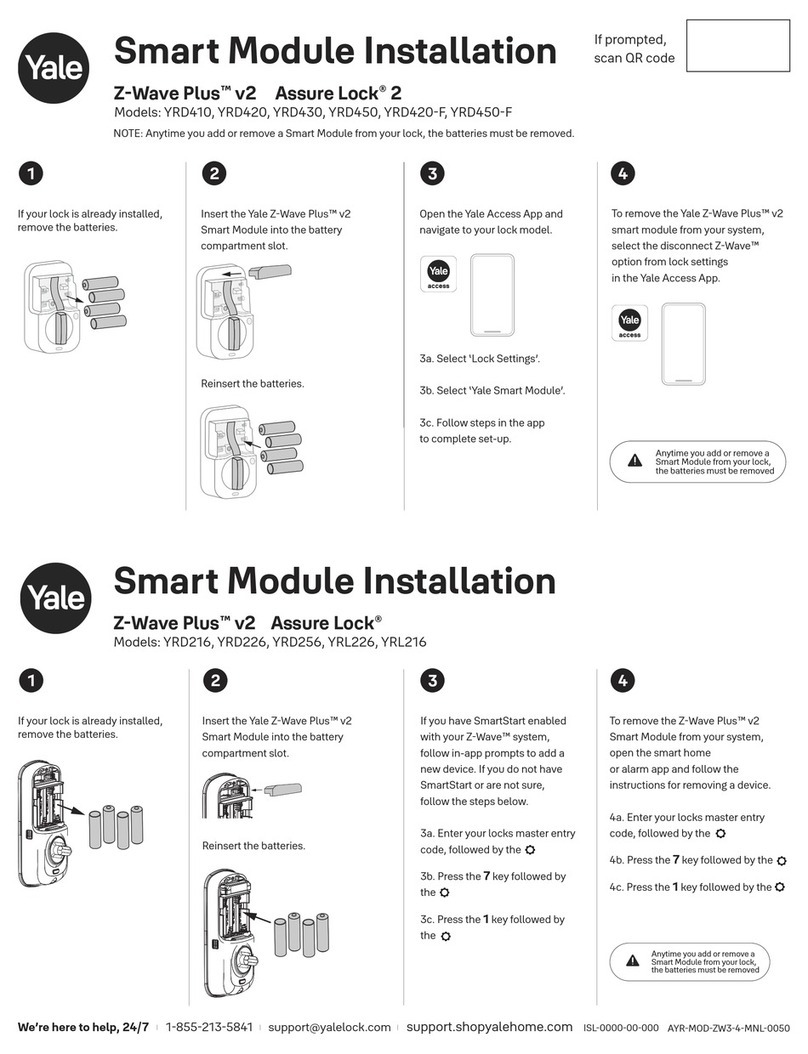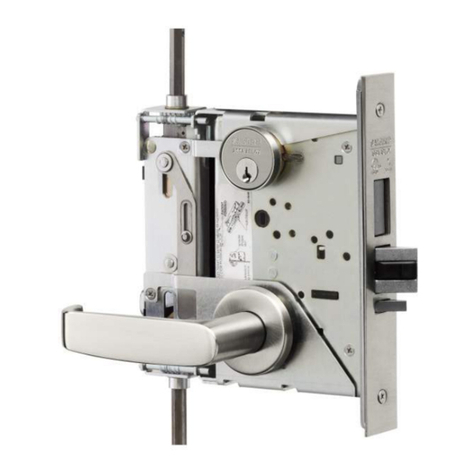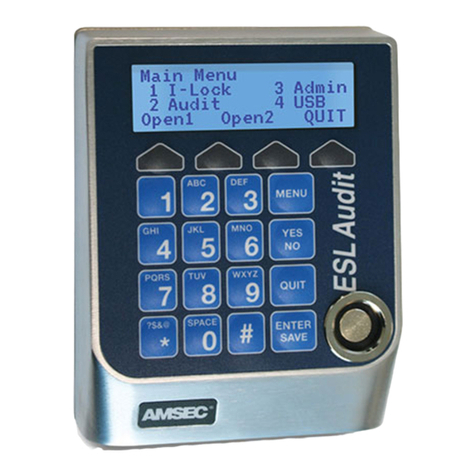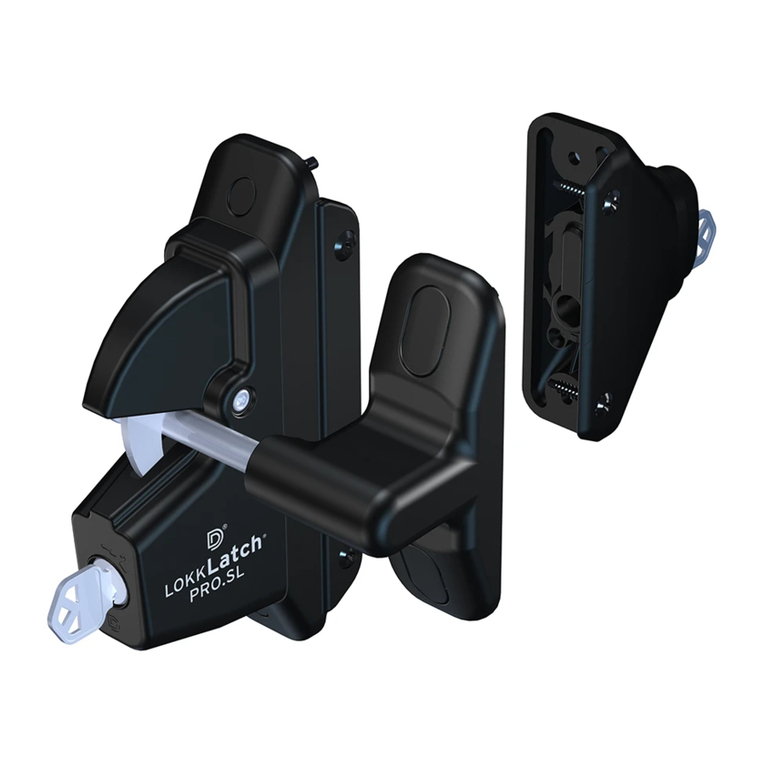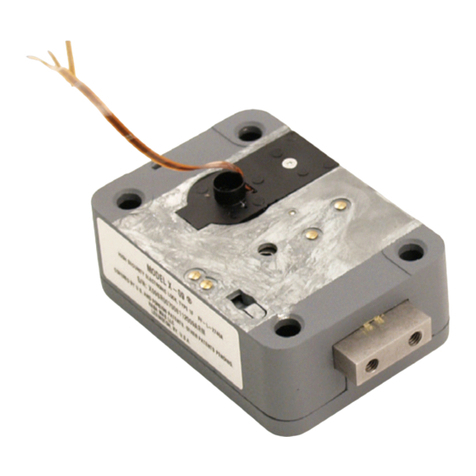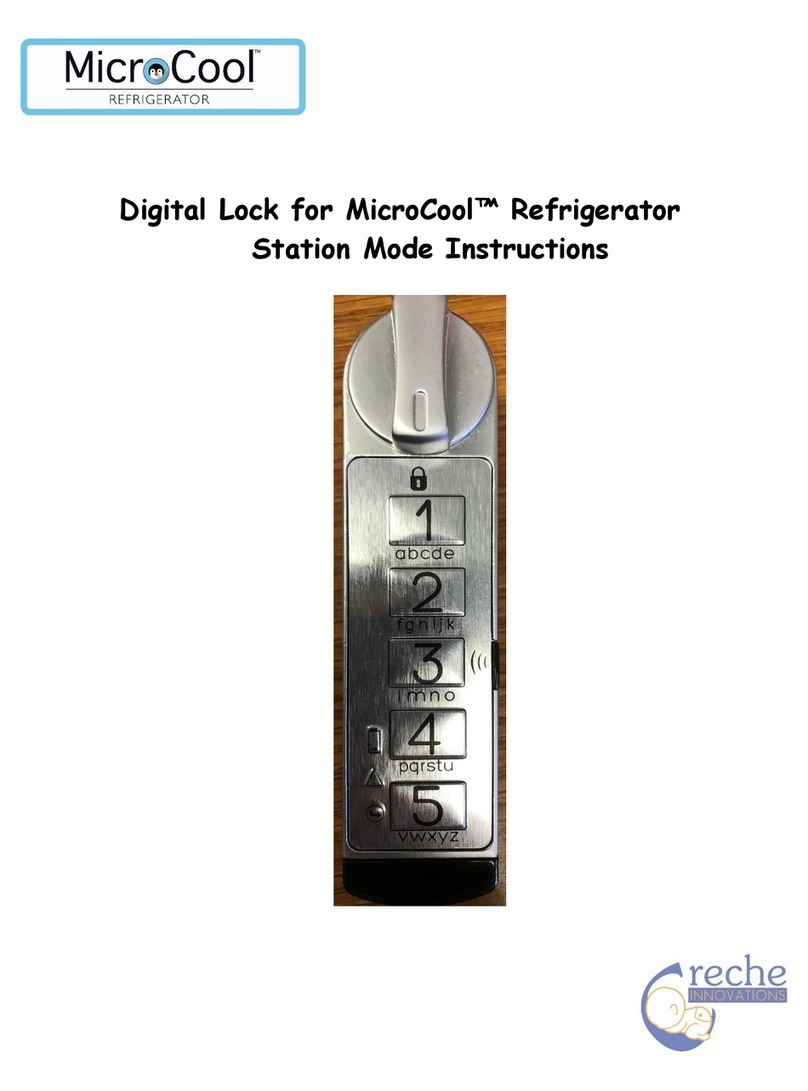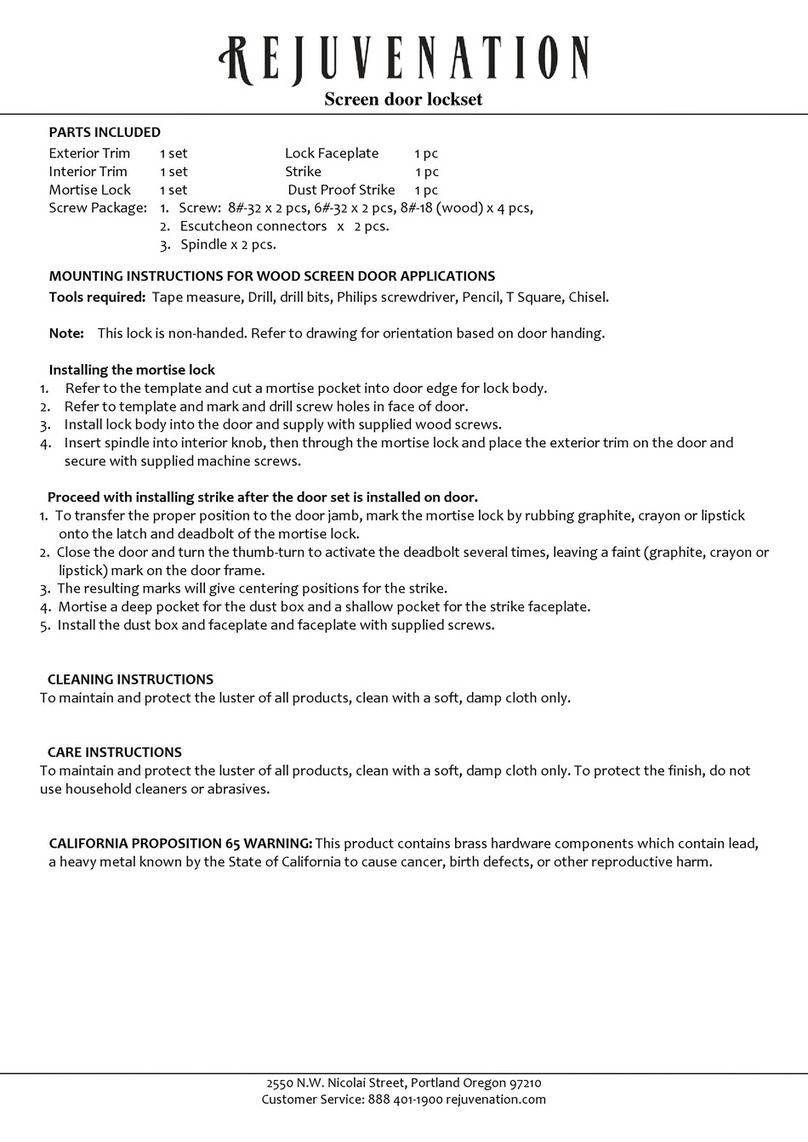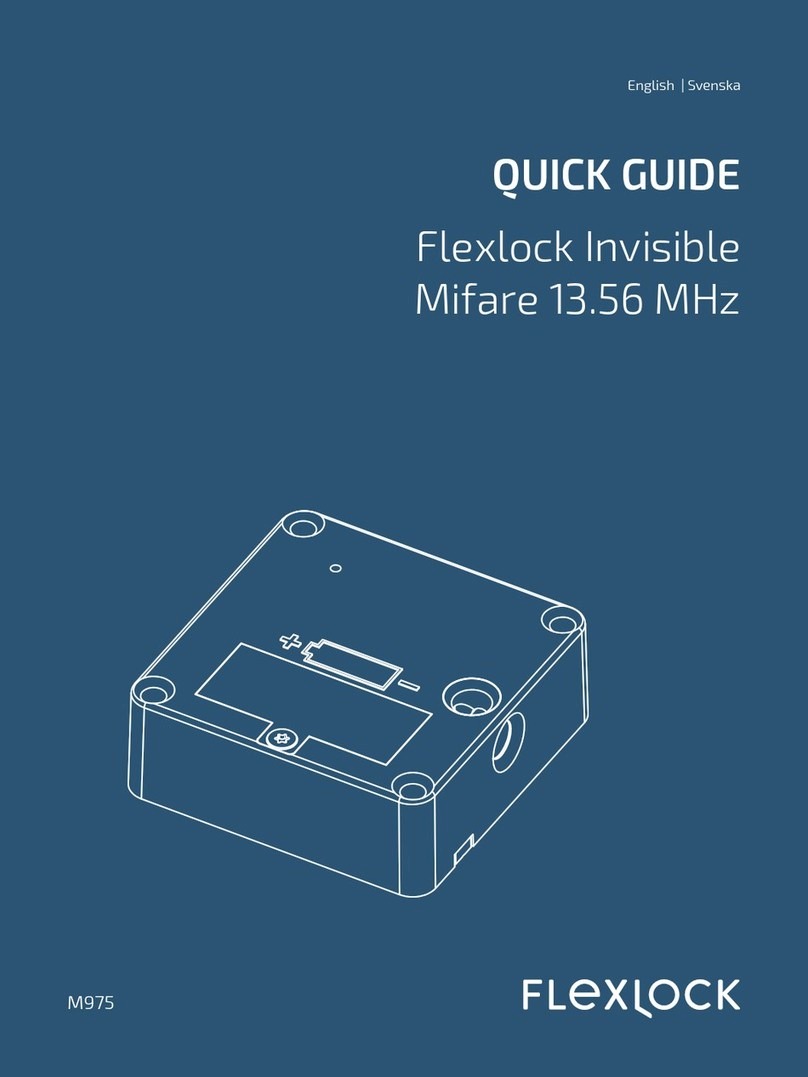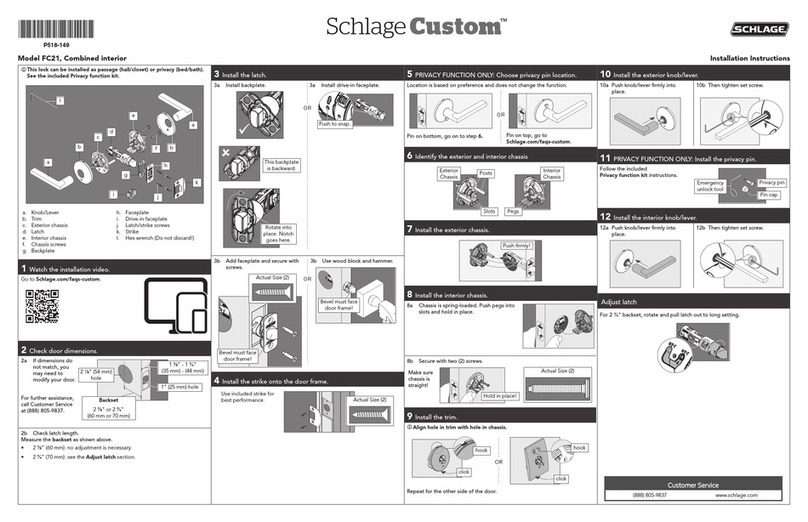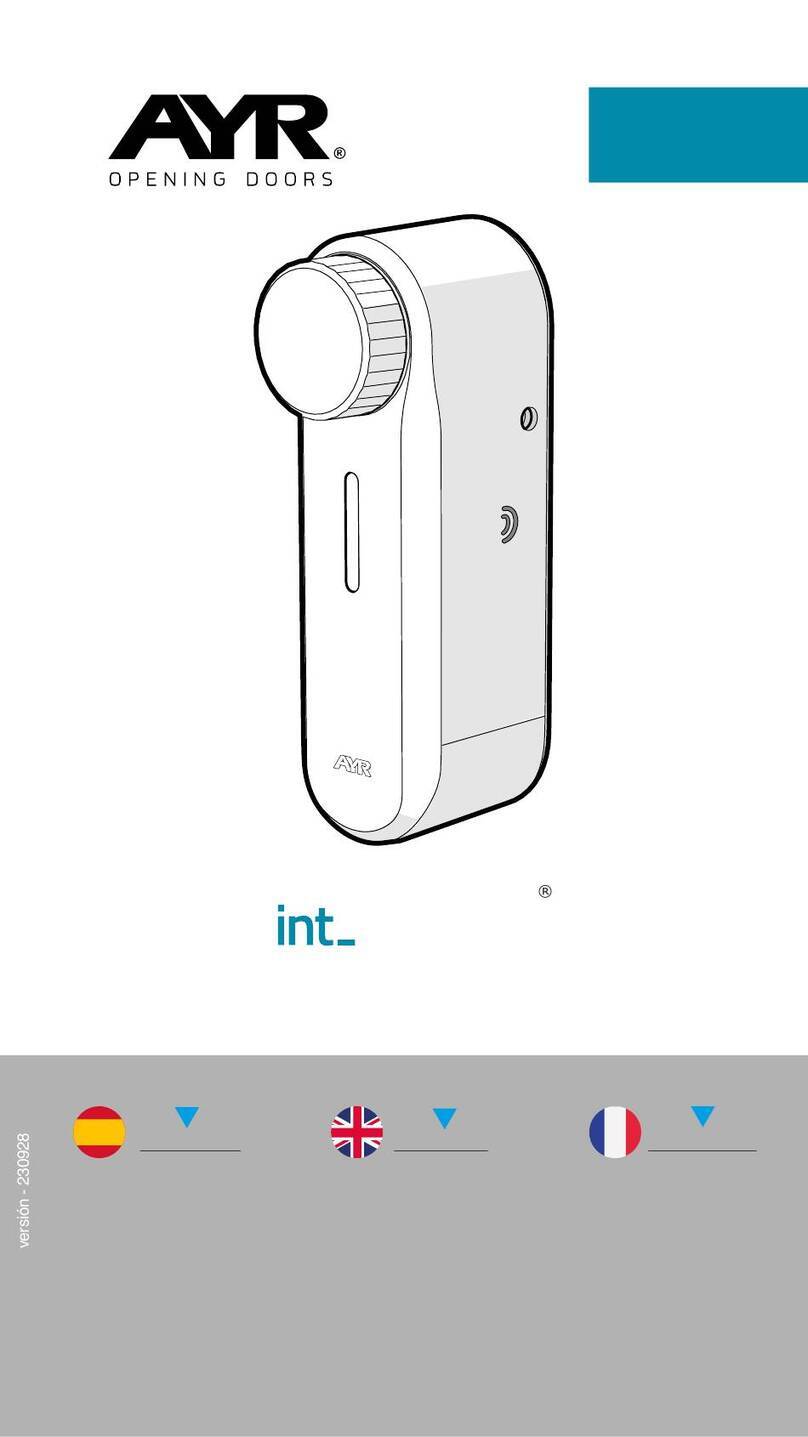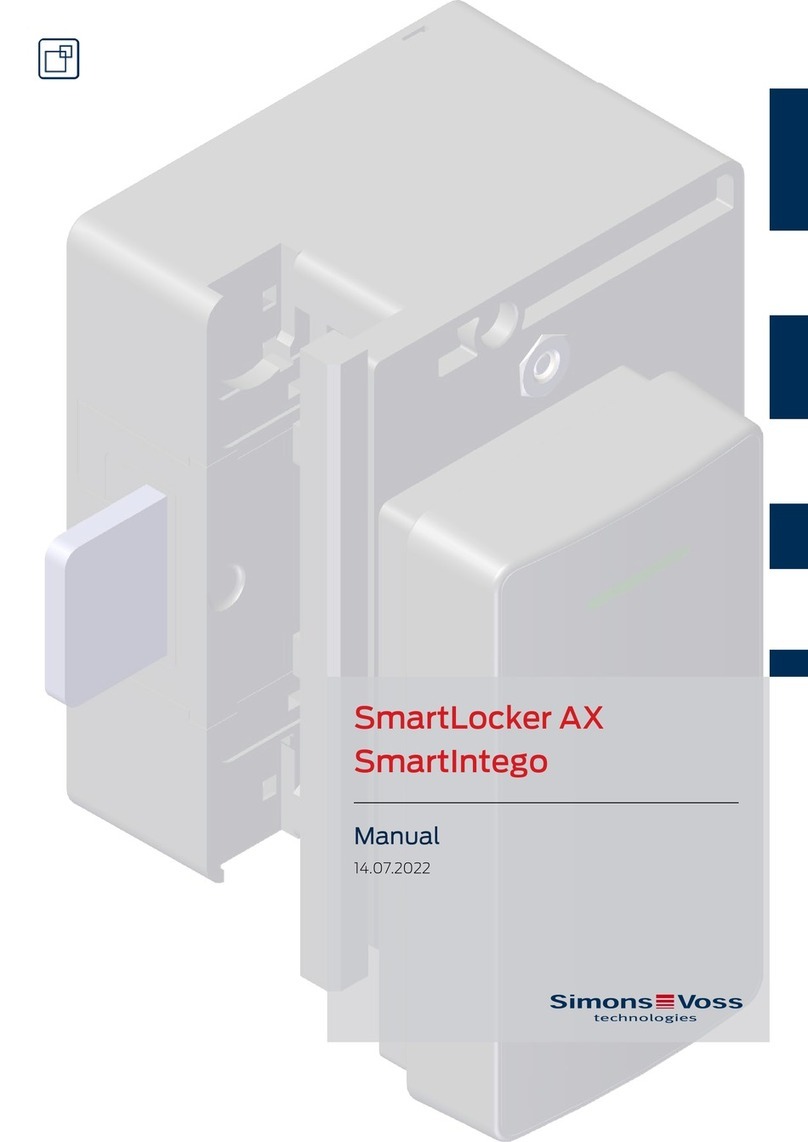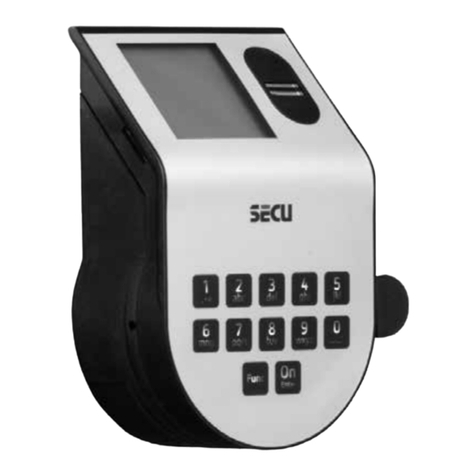Fortune Z-Wave Plus Yale Assembly Instructions

1
Yale Locks
Z-Wave Plus ™System Integrators Guide
Yale Assure Electronic Connected Deadbolts
Document Revision: 1.0
July 2023

2
Contents
Revision History ......................................................................................................3
Yale Z-Wave Plus ™Product Info ...........................................................................4
Network Operations ................................................................................................4
Enroll/Add device to network (Classic Inclusion Mode) for Assure 2 Lock ........................4
Un-enroll/Remove device from network (Exclusion Mode).............................................4
Factory Reset .........................................................................................................5
Supported Command Classes .................................................................................5
Command Class Z-Wave Plus ™Info, Version 2 ..........................................................5
Command Class Manufacturer Specific, Version 2 ........................................................6
Command Class Security, Version 1...........................................................................7
Command Class Device Reset Locally, Version 1 .........................................................7
Command Class Power Level, Version 1 .....................................................................7
Command Class Version, Version 2............................................................................8
Command Class Battery, Version 1* ..........................................................................9
Command Class Door Lock, Version 2* ......................................................................9
Command Class Door Lock Logging, Version 1* ..........................................................9
Command Class Schedule Entry Lock, Version 3* ........................................................9
Command Class User Code, Version 1* .................................................................... 10
Command Class Time Parameters, Version 1* ..........................................................12
Command Class Time, Version 2* ........................................................................... 12
Command Class Firmware Update Meta Data, Version 3* ........................................... 13
Command Class Association, Version 2*................................................................... 13
Command Class Association Group Info, Version 1* .................................................. 14
Command Class Notification, Version 4* .................................................................. 16
Command Class Configuration, Version 1* ............................................................... 20
Yale Locks in Z-Wave 500 Series System Best Practices .....................................23
Communication Signal Format ................................................................................ 23
Commands Communication Timing..........................................................................24
* This command class requires security.

3
Revision History
Rev.
Details
1.0
Initial Release

4
Yale Z-Wave Plus ™Product Info
Manufacturer ID: ASSA ABLOY (0x0129)
Z-Wave™Device Type: Door Lock Keypad
Z-Wave™Role Type: Listening Sleeping Slave (LSS)
Network Operations
Enroll/Add device to network (Classic Inclusion Mode) for
Assure 2 Lock
Un-enroll/Remove device from network (Exclusion Mode)
•Enter the 4–8-digit Master PIN code followed by the key.
•Press the key followed by the key.
•Press the key followed by the key.
When the Yale lock is unenrolled/excluded from the network through the device
menu mode, any changes previously made to the user code database and
configuration settings will be retained, as opposed to set back to defaults.

5
Factory Reset
•Factory resetting the lock with the Z-Wave™module installed will clear the Z-
Wave™network settings, causing the device to be removed from the
network.
•The following is the method of performing a factory reset:
1. Manual factory reset, via power cycle while holding button on inside
lock escutcheon.
▪See the Lock Installation Manual for details.
▪Please use the manual factory reset procedure only when the
network primary controller is missing or otherwise inoperable.
Supported Command Classes
The Yale Assure Z-Wave Plus ™deadbolts follow the Z-Wave™Command Class
Specifications for all command classes that are implemented. Please refer to these
specifications for specifics on how each command class works. The supported
command classes are listed below, and certain sections contain details about
operations that may be specific to the Yale lock. If a section is blank, then please
refer to the Z-Wave™specifications.
As a secure device, most of the command classes supported by the lock are
required to be sent securely with Z-Wave™security. During enrollment, the
controller can use the Security Command Class to get this list directly from the
lock. If a command class requires security, it is also indicated as such below.
Specification used:
-sds12657-11_z-wave_command_class_specification_a-m
-sds12652-12_z-wave_command_class_specification_n-z
Command Class Z-Wave Plus ™Info, Version 2
The Z-Wave Plus ™Info command class reports the following information:
•Role Type: Slave Sleeping Listening (0x07)
•Node Type: Z-Wave Plus ™Node (0x00)
•Installer Icon Type: 0x0300
•User Icon Type: 0x0300

6
Command Class Manufacturer Specific, Version 2
The Manufacturer Specific command class reports the following information:
•Manufacturer ID: 0x0129
oThis is the manufacturer ID assigned to ASSA ABLOY.
•Product ID:
oThe Product ID can be used to differentiate between hardware
platforms, as well as between ZW2 and ZW3. See Table 1 - First 2
Digits of Product ID, below, for details.
oProduct IDs for the locks covered in this document are as follows:
▪0x05D1 for YRD410-ZW2 (2nd Generation Assure Keyed Push
Button Deadbolt)
▪0x05D2 for YRD420-ZW2 (2nd Generation Assure Keyed Touch
Screen Deadbolt)
▪0x05D3 for YRD430-ZW2 (2nd Generation Assure Keyless Push
Button Deadbolt)
▪0x05D5 for YRD450-ZW2 (2nd Generation Assure Keyless Touch
Screen Deadbolt)
▪0x05D1 for YRD614-ZW2 (2nd Generation Assure Keyed Push
Button Deadbolt for PRO Customers)
▪0x05D2 for YRD624-ZW2 (2nd Generation Assure Keyed Touch
Screen Deadbolt for PRO Customers)
▪0x05D3 for YRD634-ZW2 (2nd Generation Assure Keyless Push
Button Deadbolt for PRO Customers)
▪0x05D5 for YRD654-ZW2 (2nd Generation Assure Keyless Touch
Screen Deadbolt for PRO Customers)
•Product Type ID:
o0x8104 for YRD410-ZW2, YRD420-ZW2, YRD430-ZW2, YRD450-ZW2,
YRD614-ZW2, YRD624-ZW2, YRD634-ZW2 & YRD654-ZW2 (2nd
Generation Assure Deadbolt)
Table 1 - First 2 Digits of Product ID
Z-Wave™
Type
Platform
Hex Value
[0x8104]-ZW2
0
0
0
0
0
1
0
1
0x05
[0x8104]-ZW3
0
1
0
0
0
1
0
1
0x45

7
Command Class Security, Version 1
This command class has been implemented per the Z-Wave™Specification.
Command Class Device Reset Locally, Version 1
The Yale door locks covered in this guide can be reset to their factory default
settings by manually resetting the lock or by BLE command via app for BLE locks
(by following the procedure outlined in the specific lock’s manual).
Upon factory reset, all Z-Wave™network settings are cleared, all the user codes are
erased from the lock (including the master code), and all configurable settings are
reset to default values, except for the language setting. A factory reset leaves the
lock in a completely unsecure state (waiting for master code to be set), so care
should be taken if using the configuration parameter to perform a remote reset.
However, if the DUT is unenrolled/excluded from the network through the device
menu mode, then the user code database and configuration settings will not be
reset to the defaults.
Command Class Power Level, Version 1
This command class has been implemented per the Z-Wave™Specification.
The Power Level command class was implemented to allow controllers to set the
transmit power for the door lock. This could be useful in large networks with many
nodes, so that the lock can find working routes back to the controller while
transmitting at a lower power. This ensures robust routes when the normal transmit
power level is restored.
Currently there is no way to initiate a low power enrollment; this command class
can only be used once the lock is enrolled successfully.

8
Command Class Version, Version 2
The Yale Real Living locks are a multi-processor system with 1 additional firmware
target. All processors can be updated through the Firmware Update Meta Data
command class. The firmware targets are numbered as follows:
•Firmware Target 0 = Z-Wave™Chip
•Firmware Target 1 = Lock Processor
To identify the firmware version for each target, the hex data in the firmware
version report must be converted to decimal prior to combining major and minor
version into the full version.
After a controller sends a Version Get command the log will display the Version
Report similar to the below:
The above Version Report will be defined as this in the Z-Wave™sniffer tool,
Zniffer:
For Firmware Target 0, the Firmware 0 Version (0x02) and Sub version (0x22)
translate to module firmware decimal value of “2.34”.
For Firmware Target 1 (the data under vg1), Firmware Version (0x2C) and Sub
version (0x00) translate to lock firmware decimal value of “4.3.00”.

9
Command Class Battery, Version 1*
* This command class requires security.
Per the Z-Wave Plus ™Specification, the lock will send a Battery Report with a
value of 0xFF to the Lifeline node when a critical battery level is reached (starting
at about 4.2V for Product Type ID 0x8104). In addition, the Yale Locks provide 2
earlier low battery alarms through the notification command class (see Table 7 -
Notification Table).
Low battery alarms will be generated if the lock is in a low battery state during one
of the following events: any motor activation (keypad lock/unlock, RF lock/unlock,
etc.), controller sends Get Battery command, or the unsolicited battery report was
triggered. Yale locks will generate an unsolicited Battery Report at lock boot-up and
every 8 hours if a node is listed in the Lifeline Group.
Command Class Door Lock, Version 2*
* This command class requires security.
Yale Z-Wave Plus ™locks support three door lock modes: Door Secured (0xFF),
Door Unsecured (0x00), and Door Unsecured with timeout (0x01). When Auto
Relock is enabled, the lock will automatically relock after all unlock events. Yale Z-
Wave Plus ™locks do not support any of the “Door Unsecured for outside Door
Handles”(0x20, 0x21) or “Door Unsecured for inside Door Handles” (0x10, 0x11)
modes.
Command Class Door Lock Logging, Version 1*
* This command class requires security.
This command class has been implemented per the Z-Wave™Specification.
Command Class Schedule Entry Lock, Version 3*
* This command class requires security.
Yale locks support Year Day Schedule types and Daily Repeating Schedule types.
Yale locks allow the controller to apply multiple schedules to a single user. Each
user has 1 Year Day Schedule slot (Slot ID 1) and 7 Daily Repeating slots (Slot IDs
1 –7). If user scheduling is used in the lock, then the controller MUST set the
lock’s time using the Time Parameters command class.

10
Command Class User Code, Version 1*
* This command class requires security.
Version 1 of this command class can address user code slots 1 through 250 via the
User Code Set/Get/Report commands.
Table 2 –Expected Reports for Set/Get Commands
Command
Slots 1-250
Slot 251
Slots 252-254
Slot 255
Slots
256-
500
User Code CC v1:
User Code Get
User Code
Report
User Code
Report
User Code
Report
User Code
Report
N/A
User Code CC v1:
User Code Set
User Code
Report
Master Code
Report
User Code
Report
User Code
Report
N/A
The master code can be accessed (read/write) using slot 251 (0xFB), if using
version 1 of this command class.
Yale locks do not support bulk commands (setting or getting multiple user codes at
once) or CRC functionality for this command class.
The following implementation notes apply specifically to non-access user codes:
•The usage of non-access users has changed slightly with ZW3, compared to
ZW2, but is still backwards compatible. If a User Code Set is transmitted
using version 1 of the command class, then the lock will accept a value of
0x04 as the status for the non-access user.
•A non-access user can be identical to a “normal”PIN code, aside from the
fact that it does not grant access.
•Any available user code slot (except the master code) can be used to store
non-access user code.
•Schedules can be applied to non-access users.

11
Yale locks support the following User ID Status values:
Table 3 - User ID Status User Code CC v1
User ID Status
User Code CC v1 Set
User Code CC v1 Report Value
Description
Value
Value
Available
0x00
0x00
Enabled / Grant Access
0x01
0x01
Disabled
0x02
0x03
0x03
Messaging:
The user code is accepted,
but the lock does not grant
access to the user. Instead, it
generates an alarm to the
Lifeline and does NOT take
preventative actions for
further attempts to enter the
User ID and/or User Code.
0x04
0x04
One-Time Use:
This PIN is disabled
immediately after being used
for a successful unlock
operation.
0x06
0x06
Expiring:
This PIN is disabled once a
specified amount of time has
passed after being used for a
successful unlock operation.
The expiration time is set
through the Configuration
command class.
0x07
0x07

12
Command Class Time Parameters, Version 1*
* This command class requires security.
The controller must set the Time Parameters in the lock anytime the lock loses
power. If the time is not set by the controller, then user codes with schedules
applied to them cannot be granted access. When the lock is powered up, it will
generate a Notification Report to indicate to the controller that power has been
applied (Alarm V1 Type = 0x82, Alarm V1 Level = 0x00, Event Type = 0x08, Event
Value = 0x01). This indicates to the controller that the lock no longer has a valid
time set.
If the controller does not support either the Time CC or Time Parameters CC, then
scheduled users will not have access.
Command Class Time, Version 2*
* This command class requires security.
The controller must set the Time Parameters in the lock anytime the lock loses
power. Even though the Time CC is not secure, the Time Set command must be
issued at the same or higher security level as when the device was enrolled for time
to be set otherwise it will be rejected by the device. After 10 seconds from lock
enrollment, if there are no messages from the controller the lock will initially
request the Time (by sending Time Get and Time Parameter Get commands). If the
time is not set by the controller, then user codes with schedules applied to them
cannot be granted access. When the lock is powered up, it will generate a
Notification Report to indicate to the controller that power has been applied (Alarm
V1 Type = 0x82, Alarm V1 Level = 0x00, Event Type = 0x08, Event Value = 0x01).
This indicates to the controller that the lock no longer has a valid time set.
If the controller does not support either the Time CC or Time Parameters CC, then
scheduled users will not have access.
A time sync should occur every 8 hours, starting with the Time CC. If there is no
response within a minute, the next step is to issue a Time Parameters Get to sync
time.

13
Command Class Firmware Update Meta Data, Version 3*
* This command class requires security.
Yale Z-Wave Plus ™locks support over-the-air (OTA) upgrading of 2 firmware
targets:
1. Firmware Target 0: Z-Wave™chip
2. Firmware Target 1: The lock main processor
Firmware Target 0 is used to determine the correct Z-Wave™processor image to
download. Firmware Target 0 ID is always 0x0301, to signal this is a Z-Wave™
image.
Firmware 1 target will depend on which version of the lock is in use (mapped to the
Product Type ID).
•For YRD410-ZW3, YRD420-ZW3, YRD430-ZW3, YRD450-ZW3, YRD614-ZW3,
YRD624-ZW3, YRD634-ZW3 & YRD654-ZW3 (2nd Generation Assure
Deadbolt), Firmware 1 ID = 0x8104
After an OTA is performed (a Firmware Update Status Report should return with
successful), there is an additional step internally where we write/apply the image to
the lock/module. When the image is being applied to the lock, the lock is
unresponsive until completion of the applied image. Once the completion of the OTA
image is applied the lock silently reboots.
Command Class Association, Version 2*
* This command class requires security.
This command class has been implemented per the Z-Wave™Specification.

14
Command Class Association Group Info, Version 1*
* Command Class Requires Security
Yale locks support the Lifeline Association Group.
Table 5 - Association Table
Group ID
Maximum Nodes
Description
Commands
1
1
Lifeline
•Command Class Battery
oBattery Report
•Command Class Configuration
oConfiguration Report
•Command Class Notification
oNotification Report
•Command Class Device Reset Locally
oDevice Reset Locally Notification

15
The following are the actions to trigger the reports:
Table 6 –Lifeline Report Trigger Table
Report Command
RF Trigger
Manual Trigger
Battery Report
Any RF Lock Operation when lock is
under the battery thresholds
Any manual/keypad Lock Operation
when lock is under the battery
thresholds or Power Cycle Lock
Configuration Report
Configuration Set
Change Lock Settings via Keypad
Notification Report (Access Control)
Any RF Lock Operation
Manual or Keypad Unlock/Lock
Notification Report (Power
Management)
Any RF Lock Operation when lock is
under the battery thresholds
Any manual/keypad Lock Operation
when lock is under the battery
thresholds or Power Cycle Lock
Device Reset Locally Notification
HW Factory Reset

16
Command Class Notification, Version 4*
* This command class requires security.
Table 7 - Notification Table
Alarm Reports
Alarm
type
Alarm
Level
Description
Notification
Type
Event
Deadbolt Jammed
0x09
0x01
Deadbolt jammed while locking
0x06
0x0B
0x02
Deadbolt jammed while unlocking
0x06
0x0B
Keypad Lock
0x12
0x (01 –
max
users)
Where Alarm level represents user slot number
0x06
0x05
Keypad Unlock
0x13
0x (01-
max
users)
Where Alarm level represents user slot number
(0x00 = Master Code)
0x06
0X06
Manual Lock
0x15
0x01
by key cylinder or inside thumb-turn
0x06
0x01
0x02
by touch function (lock and leave)
0x06
0x01
0x03
By inside button
0x06
0x01

17
Manual Unlock
0x16
0x01
By key cylinder or inside thumb turn
0x06
0x02
0x02
By inside button
0x06
0x02
RF Operate Lock
0x18
0x01
by RF module
0x06
0x03
RF Operate Unlock
0x19
0x01
by RF module
0x06
0X04
Auto Lock Operate
Locked
0x1B
0x01
Auto re-lock cycle complete, locked.
0x06
0x09
User deleted
0x21
0x (01-
max
users)
User was deleted. Alarm level = user slot
number
0x06
0X0D
(single)
0xFF ¹
All User codes were deleted
0X0C
(all)
Non-Access
0x26
0x (01-
max
users)
A Non-Access Code was entered at the lock.
Where alarm level represents user slot number
0x06
0xFE
Door State /
DoorSense™²
0x2B
0x00
Door is open
0x06
0x16
0x01
Door is closed
0x06
0x17
0x02
Door Propped (Door Open for longer than
configurable door
propped time)
0x06
0xFE

18
Daily Repeating
Schedule Set/Erased
0x60
0x (01-
max
users)
Schedule(s) has been set/erased for specified
user ID
0x06
0xFE
Daily Repeating
Schedule
Enabled/Disabled
0x61
0x (01-
max
users)
Daily Repeating Schedule(s) were
enabled/disabled for User ID specified in Alarm
Level. If Alarm Level = 0xFF then all users were
affected.
0x06
0xFE
Year Day Schedule
Set/Erased
0x62
0x (01-
max
users)
Schedule(s) has been set/erased for specified
user ID
0x06
0xFE
Year Day Schedule
Enabled/Disabled
0x63
0x (01-
max
users)
Year Day Schedule(s) were Enabled/Disabled
for User ID specified in Alarm Level. If Alarm
Level = 0xFF then all users were affected.
0x06
0xFE
All Schedule Types
Erased
0x64
0x (01-
max
users)
All Schedule Types were Set (erased/set) for
User ID specified in Alarm Level. If Alarm Level
= 0xFF then all users were affected.
0x06
0xFE
All Schedule Types
Enabled/Disabled
0x65
0x (01-
max
users)
Schedule(s) has been enable/disabled for
specified user ID. If Alarm Level = 0xFF then all
users were affected.
0x06
0xFE
Master Code changed
0x70
0x00
Master code was changed at keypad
0x06
0x12
0xFB
Master code was changed via RF
0x06
0X0E
User added
0x (01-
max
users)
User added. Alarm level = user slot number
0x06
0X0E
Duplicate Pin code error
0x71
0x (01-
max
users)
Where Alarm level represents user slot
Number, an Alarm is generated in response to
add user via RF.
This alarm is not generated when attempting to
add duplicate pin at the
Keypad (The lock simply denies it and
plays the “Denied” sound.) Trying to duplicate
the master code will result in a 0x71 0x00
alarm report.
0x06
0x0F

19
Door Lock needs Time
set / RF Module Power
Cycled
0x82
0x00
Power to the lock was restored and the locks
RTC was cleared. The controller should set the
time to ensure proper logging.
0x08
0x01
Disabled user entered at
keypad
0x83
0x (01-
max
users)
A disabled user pin code was entered at the
keypad
0x06
0xFE
Valid user but outside of
schedule
0x84
0x (01-
max
users)
A valid user can be both a normal user and a
non-Access user. If a non-access user is out of
schedule this alarm will be sent instead of the
non-access alarm.
0x06
0xFE
Tamper Alarm
0xA1
0x01
keypad attempts exceed code entry limit
0x06
0X10
0x02
front escutcheon removed from main
0x06
0xFE
Low Battery Alarms ³
0xA7
0x
(Current
%)
Low Battery
Starting at 4.6V
0x08
0x0A
0xA8
0x
(Current
%)
Critical Battery Level Starting at 4.4V
0x08
0x0B
Integrated BLE Lock ⁴
0xE2
0x00
Integrated BLE Lock
0x06
0x03
0x01
Integrated BLE Auto Relock
0x06
0x09
Integrated BLE Unlock ⁴
0xE3
0x00
Integrated BLE Unlock
0x06
0X04
0x01
Integrated BLE Auto Unlock
0x06
0X04
Homekit BLE Lock ⁴
0xE4
0x00
Integrated Homekit BLE Lock
0x06
0x03
Homekit BLE Unlock ⁴
0xE5
0x00
Integrated Homekit BLE Unlock
0x06
0X04
¹ Deleting all user codes will also delete any associated schedules (year day and daily repeating scheduled pin codes) assigned to user codes.
² This requires additional Hardware and calibration within the Yale Access App.
³ The Yale lock also supports a 3rd low battery alarm: too low to operate. This alarm is sent out as a Battery Report (with value = 0xFF)
through the Battery Command Class. This is the last low battery alarm level before the product stops functioning. Starting at 4.2V (0x8104)
⁴ Needs Yale Access App setup.

20
Command Class Configuration, Version 1*
* This command class requires security.
Table 8 - Configurable Parameters
Param.
Num.
Name
Length
Configuration Properties
Info
Length of
Info String
Min
Max
Default
(Max
length
allowed is
90)
1
Volume
1 byte
0x01 (High
Volume)
0x03 (Silent)
0x01 (High
Volume)
[0x8104]
Set Volume Level to
high (1), low (2), or
silent (3). [0x8104]
53
2
Auto Relock
1 byte
0x00
(Disable)
0xFF
(Enable)
0x00
(Disable)
Set Auto Relock feature
to enable or disable.
45
3
Relock time
1 byte
0x01 (1
seconds) ¹
0xB4 (180
seconds)
0x1E (30
seconds)
Adjust the time your
lock will auto relock.
43
Table of contents
Other Fortune Lock manuals
Popular Lock manuals by other brands

BABY DAN
BABY DAN KeyGuard instructions
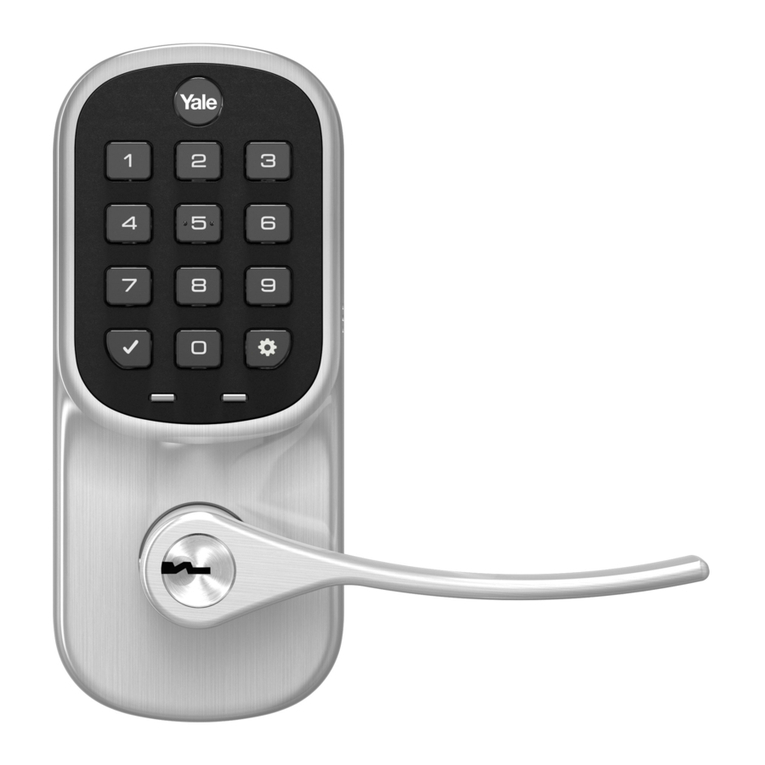
Yale
Yale Assure Lock YRL216 Installation and programming instructions
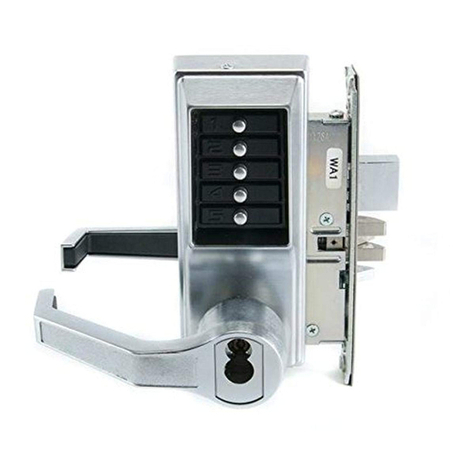
Kaba
Kaba Simplex 8100 Series installation instructions

Lock4Safe
Lock4Safe Pulse PRO instruction manual
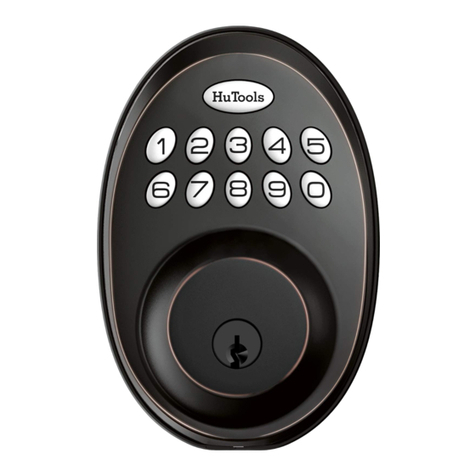
HuTools
HuTools HT01 Program manual
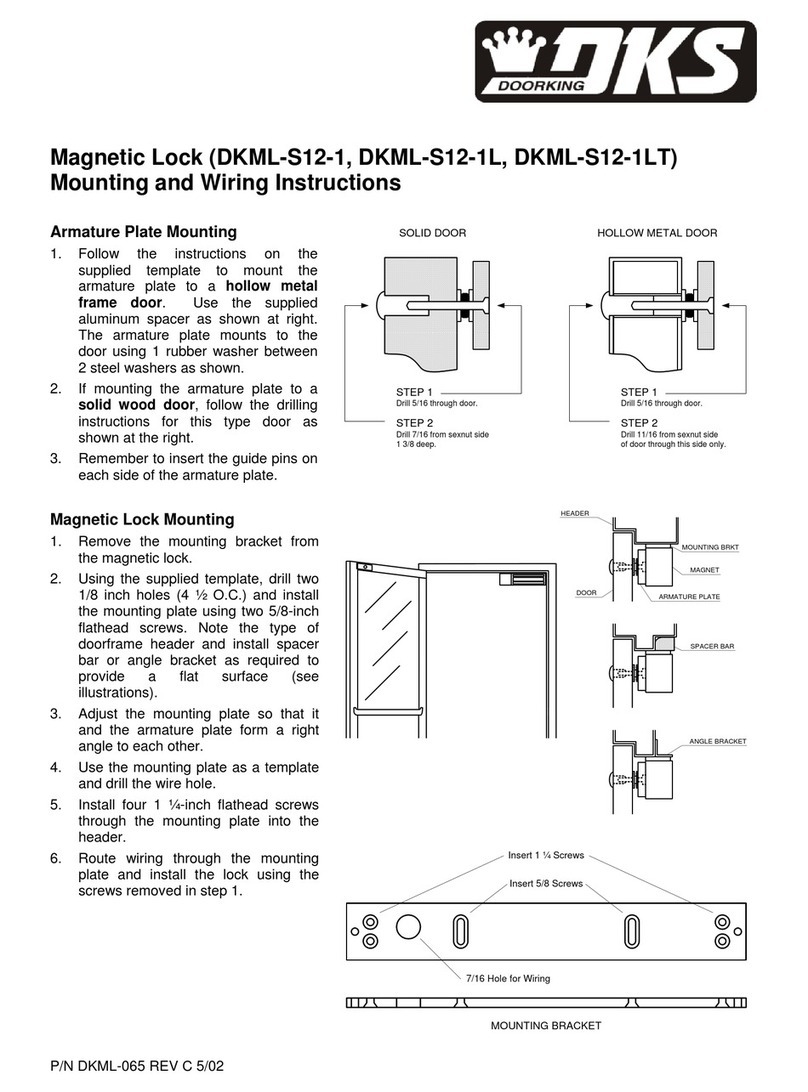
DoorKing
DoorKing DKML-S12-1 Mounting and wiring instructions
